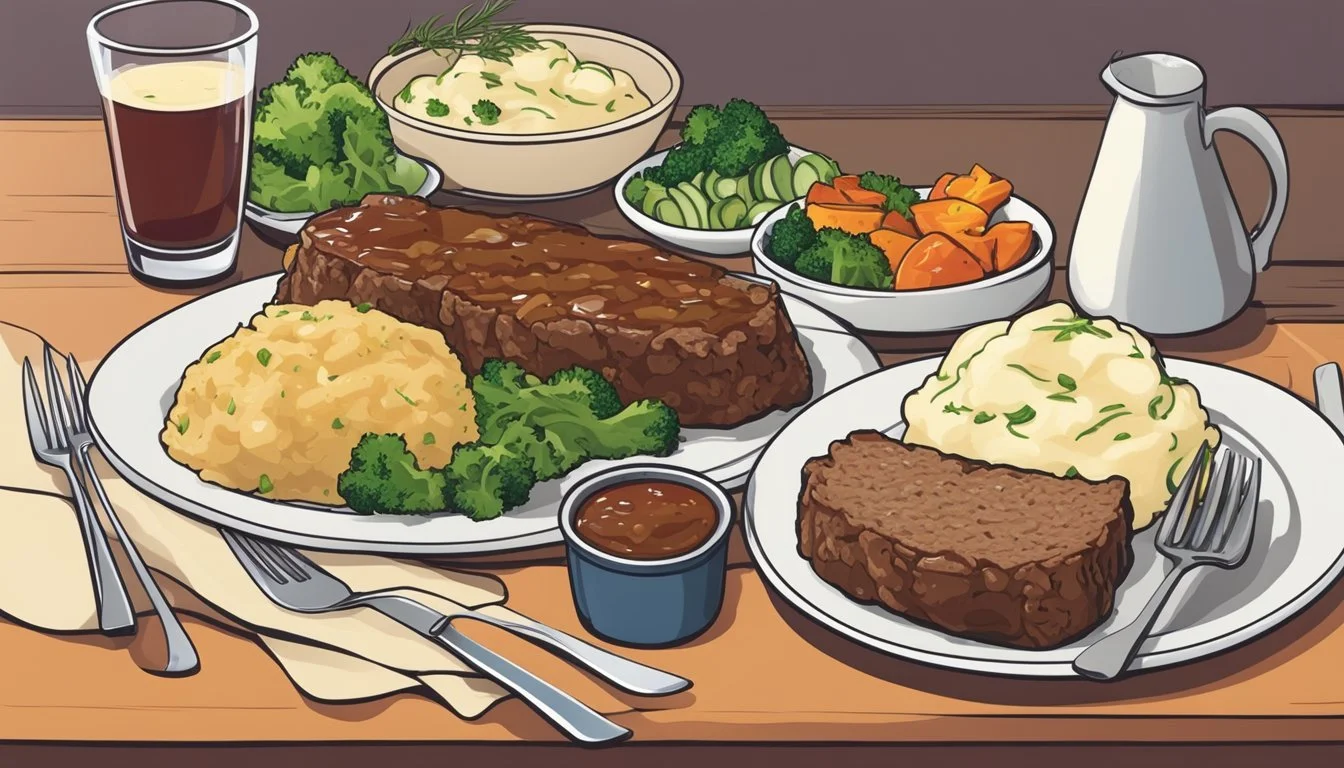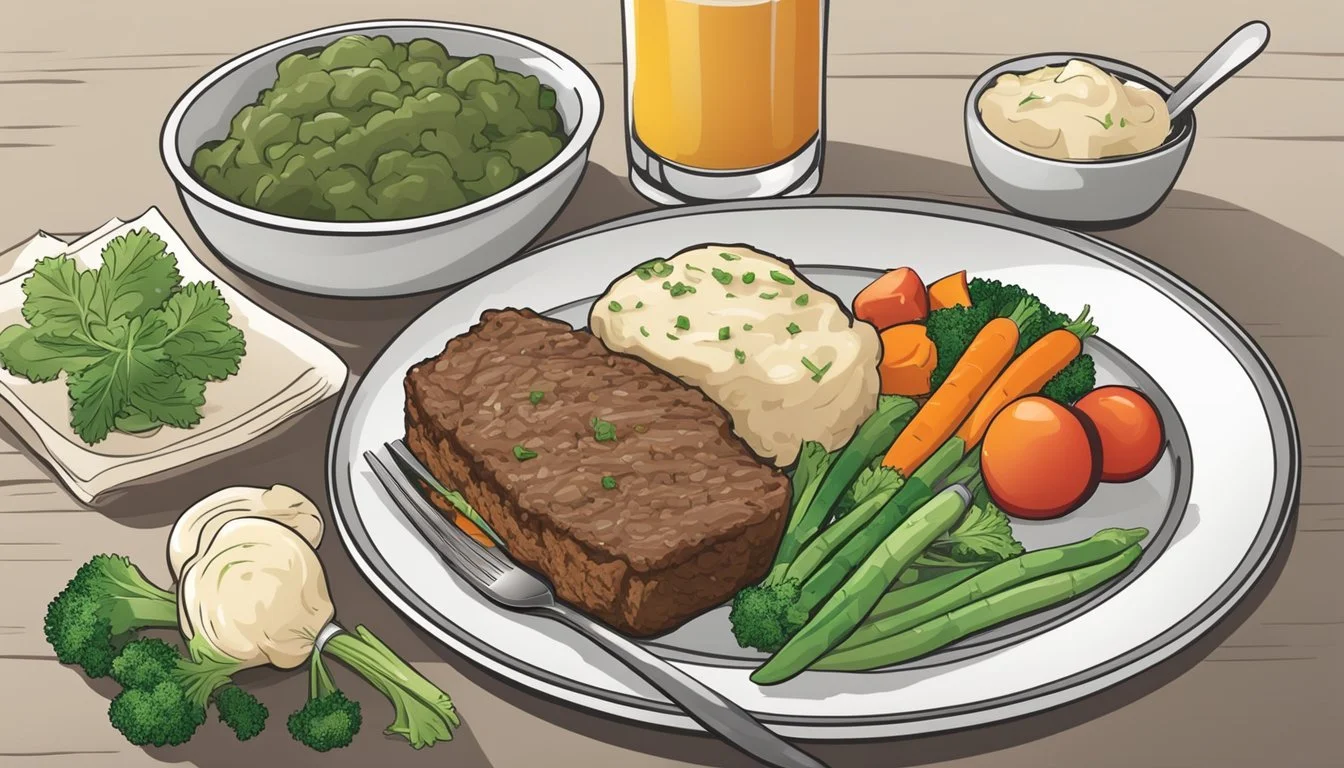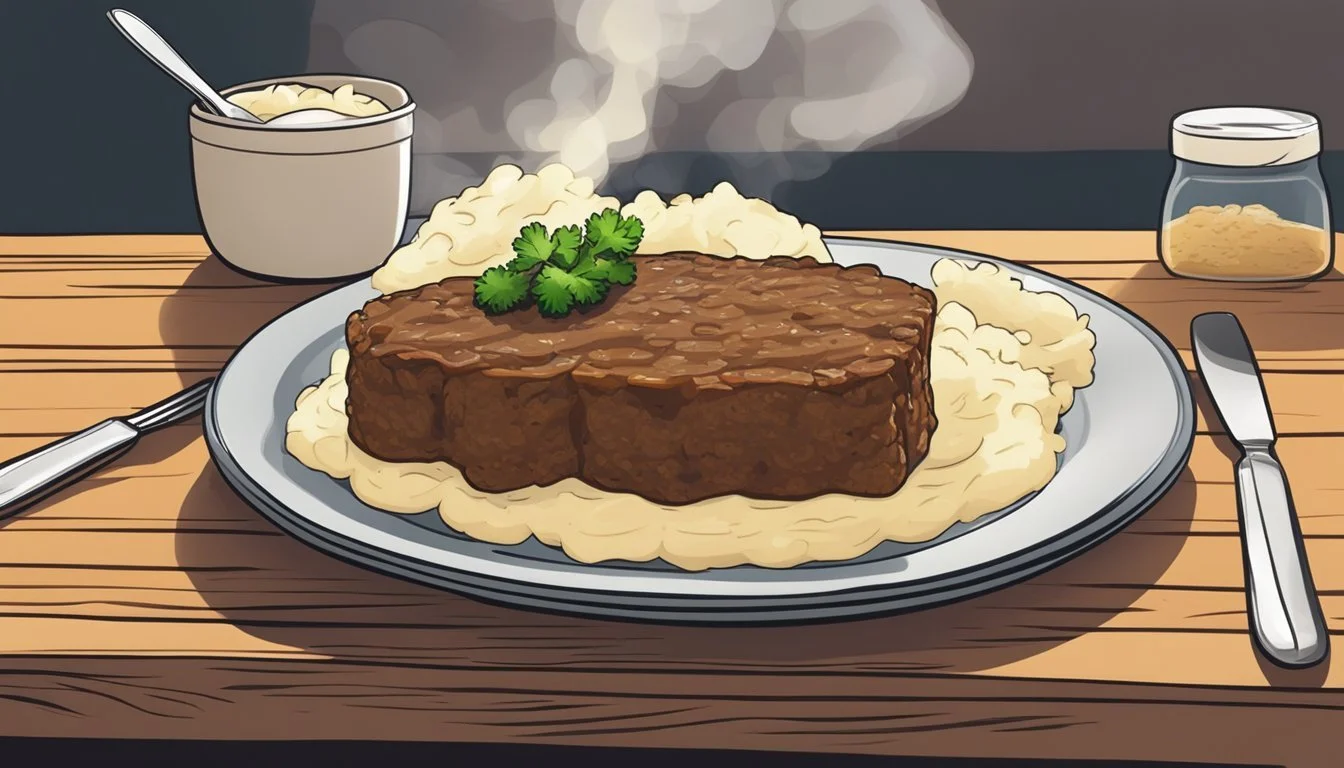How to Reheat Gluten-Free Meatloaf with Mashed Potatoes
Expert Tips for Perfect Results
Reheating gluten-free meatloaf with mashed potatoes can be straightforward while maintaining the delicious textures and flavors. For optimal results, place the meatloaf in a shallow baking dish, add a bit of beef broth to prevent drying out, cover with foil, and warm it in a 350ºF oven for 25-30 minutes. This method ensures the meatloaf stays moist and flavorful, a crucial aspect of comfort food like this.
Adding mashed potatoes to the equation makes the meal complete and satisfying. You can either reheat them separately in a pot with a bit of milk or butter or alongside the meatloaf for a convenient, one-pan meal. Ensuring both components are warmed through and retain their comforting characteristics is key.
By combining careful reheating techniques with classic comfort food favorites, you can enjoy the gluten-free meatloaf and mashed potatoes as they were freshly made. This approach guarantees a homely, delicious meal without compromising on quality or taste.
Understanding Gluten-Free Meatloaf
Mastering gluten-free meatloaf involves selecting suitable ingredients, effective gluten-free binders, and considering alternative meats to ensure the dish is both delicious and celiac-safe.
Choosing the Right Ingredients
When crafting gluten-free meatloaf, the quality and type of ingredients are crucial. Lean ground beef is a popular choice, providing a rich flavor and maintaining moisture. For variety, ground pork or ground turkey can also be used. Ensuring all ingredients are gluten-free is vital. Check labels on sauces like Worcestershire and soy sauce to avoid hidden gluten. Adding vegetables like onions and carrots not only boosts flavor but also adds moisture and nutrients.
Gluten-Free Binding Ingredients
Traditional meatloaf recipes often use breadcrumbs as a binder, but these must be replaced in a gluten-free version. Options include gluten-free breadcrumbs, gluten-free oats, and gluten-free bread crumbs. Almond flour is another excellent choice, providing a nutty flavor and maintaining consistency. Gluten-free bread, toasted and crumbled, can also work well. Proper binding ensures the meatloaf holds together and has a good texture, which is crucial for a satisfying meal. Popular binders like eggs should also be included.
Alternative Gluten-Free Meats
Exploring different meats can create unique flavors in gluten-free meatloaf. While lean ground beef remains a staple, ground pork offers a slightly sweeter taste. Ground turkey is a leaner option, perfect for those seeking a healthier alternative without compromising on flavor. These meats can be used individually or combined to balance flavor and texture. Experimenting with different combinations can lead to discovering new favorite recipes while keeping the meatloaf gluten-free and enjoyable for everyone, especially those with celiac disease.
Gluten-Free Meatloaf Recipe Basics
Creating a gluten-free meatloaf involves careful selection of ingredients to ensure both flavor and texture are preserved. Common ingredients include ground meat, gluten-free breadcrumbs, eggs, and seasonings.
Step-by-Step Meatloaf Preparation
Begin by assembling all ingredients, ensuring everything used is gluten-free. Preheat the oven to your desired temperature, typically around 350°F. Combine ground beef or a mix of beef and pork in a large bowl.
Next, add finely chopped onions, minced garlic, and gluten-free breadcrumbs. Crack an egg into the mixture to act as a binder, keeping the meatloaf together during cooking. Mix these ingredients just until combined to avoid a dense texture.
Choose your baking method; either form a loaf on a parchment-lined baking sheet or use a 9x5 loaf pan. If using a loaf pan, line it with parchment paper for easy removal. Bake for 45-60 minutes, depending on thickness, until the internal temperature reaches 165°F. Allow the meatloaf to rest for about 15 minutes before slicing.
Seasonings and Flavorings
Seasoning is essential for a flavorful meatloaf. Start with basic seasonings such as salt and pepper, then expand to garlic powder, onion powder, and thyme. Add Dijon mustard and Worcestershire sauce for depth; ensure the Worcestershire sauce is gluten-free.
For added moisture and richness, include finely chopped vegetables like carrots or bell peppers. Some recipes suggest soaking breadcrumbs in milk before mixing, offering extra tenderness. Adjust seasonings to taste, always checking that all components are gluten-free.
In these steps, the balance of ingredients and careful seasoning are key to achieving a tasty and satisfying gluten-free meatloaf.
Making the Perfect Meatloaf Glaze
The glaze elevates meatloaf by adding a sweet and tangy flavor. Popular options include a traditional ketchup-based glaze and creative variations using BBQ sauce or tomato sauce.
Classic Ketchup Glaze
A classic ketchup glaze uses simple ingredients for a sweet and tangy finish. Combine ketchup, brown sugar, and apple cider vinegar in a small bowl. Mix until the sugar dissolves and the glaze is smooth. The ratio of ingredients typically includes:
¼ cup brown sugar
1 tablespoon apple cider vinegar
Apply the glaze to the meatloaf before baking. Spread it evenly over the top and sides using a pastry brush. Adding part of the glaze during the last 15 minutes of baking can enhance the flavor and prevent burning. The classic glaze adds a nostalgic taste reminiscent of traditional homestyle cooking.
Creative Glaze Variations
For a twist on the classic, try these variations incorporating different flavors and ingredients. A BBQ sauce glaze can bring a smoky depth, combining BBQ sauce, mustard, and honey.
½ cup BBQ sauce
2 tablespoons mustard
2 tablespoons honey
Mix until combined and slather over the meatloaf. Tomato sauce can be another option, using tomato sauce, Worcestershire sauce, and garlic powder.
1 cup tomato sauce
1 tablespoon Worcestershire sauce
1 teaspoon garlic powder
These variations offer a personalized touch, allowing different flavors to complement the meatloaf. Experimenting with these can lead to a unique and delicious glaze that fits individual preferences.
Baking Gluten-Free Meatloaf
To bake a perfect gluten-free meatloaf, precise oven settings and checking the internal temperature are essential. Here are the key steps for achieving a juicy and flavorful meatloaf.
Oven Temperature and Cooking Time
Start by preheating the oven to 350°F. This temperature ensures the meatloaf cooks evenly without drying out. Use a 9x5-inch loaf pan lined with parchment paper for easy removal.
Place the meatloaf mixture into the pan, and smooth the top. Bake for 45-60 minutes. If desired, increase the temperature to 400°F in the final 10-15 minutes to achieve a crusty top layer. Alternatively, brush the top with a glaze and broil for 3 minutes for added flavor.
Testing for Doneness
Check the meatloaf's internal temperature using a meat thermometer. Insert the thermometer into the center of the loaf. The internal temperature should be 160°F. This ensures that the meat is cooked thoroughly and safe to eat.
Additionally, observe the meatloaf's texture. It should feel firm and the juices should run clear. Another method is cutting into the center of the loaf to ensure no pink meat remains.
Preparing Gluten-Free Mashed Potatoes
Quality gluten-free mashed potatoes start with the right choice of potatoes and effective mashing techniques. These tips will ensure your mashed potatoes are smooth, creamy, and gluten-free.
Choosing the Right Potatoes
For creamy mashed potatoes, Yukon Gold or Russet potatoes are ideal choices. Yukon Gold potatoes provide a natural buttery flavor and a creamy texture, while Russet potatoes offer a fluffier consistency.
Peel and cut the potatoes into uniform chunks. This helps in even cooking. Boil the potatoes in salted water until they are fork-tender, which usually takes around 15-20 minutes. Drain thoroughly to avoid watery mashed potatoes.
Yukon Gold potatoes or Russet potatoes
Type Texture Flavor Yukon Gold Creamy Buttery Russet Fluffy Mild
Mashing Techniques
Once the potatoes are drained, add them back into the pot. For mashing, a potato masher or hand mixer can be used. Add your choice of butter or dairy-free alternatives such as olive oil or dairy-free butter to enhance the flavor.
Incorporate milk or dairy-free milk until the desired consistency is achieved. Gradually adding the liquid helps prevent the potatoes from becoming too runny. Season with salt, pepper, garlic powder, and onion powder to enrich the taste.
Ingredients such as butter, milk, and seasonings can vary based on dietary preferences but consistency and proper seasoning are essential for delicious mashed potatoes.
Reheating Meatloaf and Mashed Potatoes
Reheating gluten-free meatloaf and mashed potatoes requires techniques that preserve moisture, texture, and flavor. Whether using an oven or microwave, each method ensures your leftovers are just as enjoyable as the original meal.
Oven Reheating Method
To reheat meatloaf and mashed potatoes in the oven:
Preheat the oven to 350°F (175°C).
Place meatloaf slices in a shallow baking dish. Add 1-2 tablespoons of water or beef broth to prevent drying out.
Cover with aluminum foil and place the dish in the oven.
Bake for 25-30 minutes until the meatloaf reaches an internal temperature of 165°F (74°C). Use a meat thermometer for accuracy.
Reheat mashed potatoes in an oven-safe dish, adding a bit of milk or butter. Cover with foil to retain moisture.
Bake for 20-25 minutes, stirring halfway through to ensure even heating.
Microwave Reheating Tips
For microwave reheating:
Place meatloaf slices on a microwave-safe plate. Cover with a damp paper towel to retain moisture.
Set the microwave to medium power (50-70%) to avoid overheating.
Heat in 30-second intervals, checking and turning the slices for even warming.
Reheat mashed potatoes in a microwave-safe bowl. Add a splash of milk or a pat of butter.
Cover with a damp paper towel and heat on medium power.
Stir the potatoes every 30 seconds until fully heated.
Both methods help maintain the flavors and textures of your gluten-free meatloaf and mashed potatoes, ensuring a delicious experience even as leftovers.
Storage and Make-Ahead Tips
Proper storage ensures that gluten-free meatloaf and mashed potatoes remain safe and delicious to consume later. Following these tips will help maintain the quality of your leftovers and make it easy to plan meals ahead.
Storing Leftover Meatloaf
To store leftover meatloaf, allow it to cool to room temperature first. Wrap the meatloaf tightly in aluminum foil or plastic wrap. Alternatively, use airtight containers. Store in the refrigerator for up to 4 days.
If reheating, slice the meatloaf into desired portions before storing. This makes it easier to heat only what you need.
For mashed potatoes, place them in an airtight container. Store them in the refrigerator for 3-4 days. Adding a little extra butter or dairy-free milk when reheating can help restore their creamy texture.
Freezing and Thawing Guidelines
For longer storage, freezing is an excellent option. Freeze the meatloaf whole or slice it first for convenience. Wrap each slice individually in plastic wrap, then place them in a freezer-safe bag. Frozen meatloaf can last up to 3 months.
To freeze mashed potatoes, portion them into freezer-safe containers. Label the containers with the date to keep track of storage time. They can be frozen for up to 2 months.
To thaw, transfer meatloaf and mashed potatoes from the freezer to the refrigerator. Allow 24 hours for proper thawing. Reheat meatloaf in the oven or microwave until it reaches an internal temperature of 165°F (74°C).
For mashed potatoes, reheat gently on the stovetop or in the microwave, adding liquid as needed to maintain their texture.
Gluten-Free Side Dishes and Pairings
Enhancing a gluten-free meal like meatloaf with mashed potatoes involves pairing it with complementary side dishes and a flavorful gluten-free gravy.
Vegetable Accompaniments
Including a variety of vegetable side dishes can bring color and nutrition to your plate. Sauteed Garlic Lemon String Beans are quick to prepare, requiring only 15 minutes. The combination of garlic and lemon enhances the freshness of the beans, providing a delightful crunch. Cauliflower Gratin is another excellent choice. Although it’s rich with cream and butter, it remains gluten-free while offering a creamy texture.
For those looking to keep it light, Spanish Cauliflower Rice is both gluten-free and grain-free. With added Italian seasoning, it provides a robust flavor that pairs well with meatloaf. These vegetable options ensure a balanced meal that both satisfies and nourishes.
Creating a Flavorful Gravy
A well-prepared gravy can elevate the flavors of meatloaf and mashed potatoes. Start with gluten-free broth—either beef or vegetable based—to ensure a rich base. Add a thickening agent such as cornstarch or gluten-free flour. Cook the mixture on medium heat, stirring constantly to avoid lumps.
Incorporating seasonings such as Italian seasoning and fresh parsley can enhance the gravy's flavor profile. For a touch of complexity, you might include a splash of dairy-free milk or a knob of gluten-free butter. This approach guarantees that the gravy remains free of gluten while adding depth and richness to the meal.
Nutritional Information and Benefits
Gluten-free meatloaf paired with mashed potatoes offers a nourishing meal with a balance of proteins, carbohydrates, and essential nutrients. The combination of lean ground beef and gluten-free ingredients makes it suitable for various dietary needs.
Caloric and Macro Breakdown
The caloric content of gluten-free meatloaf primarily depends on the type and amount of meat used. Lean ground beef is a popular choice, providing approximately 250 calories, 23 grams of protein, 17 grams of fat, and zero carbs for a 3-ounce serving.
Adding oats or rice as gluten-free fillers contributes additional carbs and fiber. Typically, 1/4 cup of oats adds about 78 calories, 3 grams of protein, 1 gram of fat, and 13 grams of carbohydrates. Mashed potatoes, often served alongside, contribute approximately 100 calories, 2 grams of protein, and 17 grams of carbohydrates per half-cup serving.
Health Benefits of Gluten-Free Ingredients
Gluten-free meatloaf usually employs oats or rice, both of which have significant health benefits. Oats are a good source of fiber, which aids in digestion and can help regulate blood sugar levels. They also contain important vitamins and minerals such as iron and magnesium.
Rice, particularly brown rice, adds valuable nutrients like B vitamins and antioxidants, promoting overall wellness. Lean ground beef is a rich source of high-quality protein and essential amino acids, necessary for muscle repair and growth, making the meal both nutritious and satisfying.
Combining these ingredients makes gluten-free meatloaf a balanced, affordable, and healthy meal option for those with gluten sensitivities or anyone looking for nutritious home-cooked food.
Conclusion
Reheating gluten-free meatloaf can be simple and effective whether using a stovetop or an oven. The stovetop method quickly heats individual slices in a skillet with a bit of oil or butter.
Alternatively, using the oven ensures that a whole meatloaf retains its juiciness. Placing slices in a shallow baking dish with broth or water, then covering with foil, works well.
Accompanying these meals with mashed potatoes makes for a complete, comforting dinner. Preparing mashed potatoes involves boiling until tender, then mashing to your preferred consistency.
Creating homemade, classic dinners with a prep time of 10 minutes for the mashed potatoes ensures everything comes together smoothly.
Consider doubling your recipes for future convenience. Freezing extra portions allows for easy reheating later, maintaining the flavor and texture of a freshly made meal.
Creating a recipe card with clear instructions for reheating and preparation can also streamline the process, making these dishes accessible and enjoyable any night of the week.
The end goal is to enjoy the convenience of reheated, delicious, and safe-to-eat meals that maintain the qualities of traditional dinners while catering to gluten-free needs.








